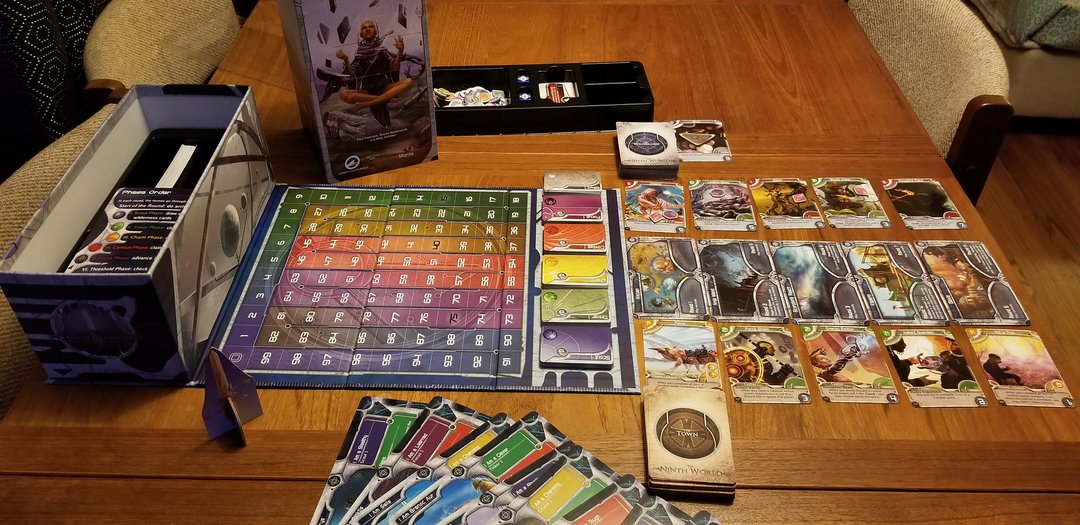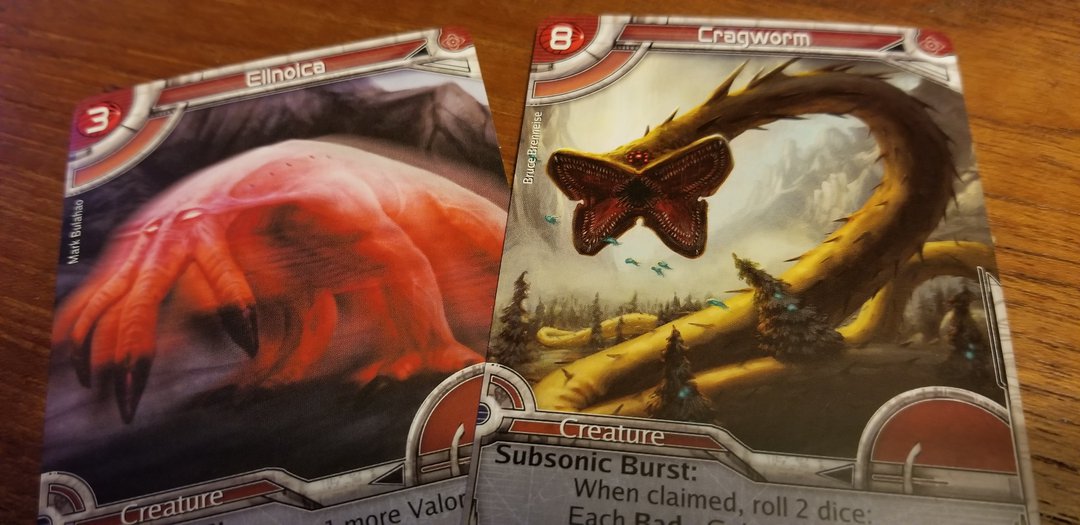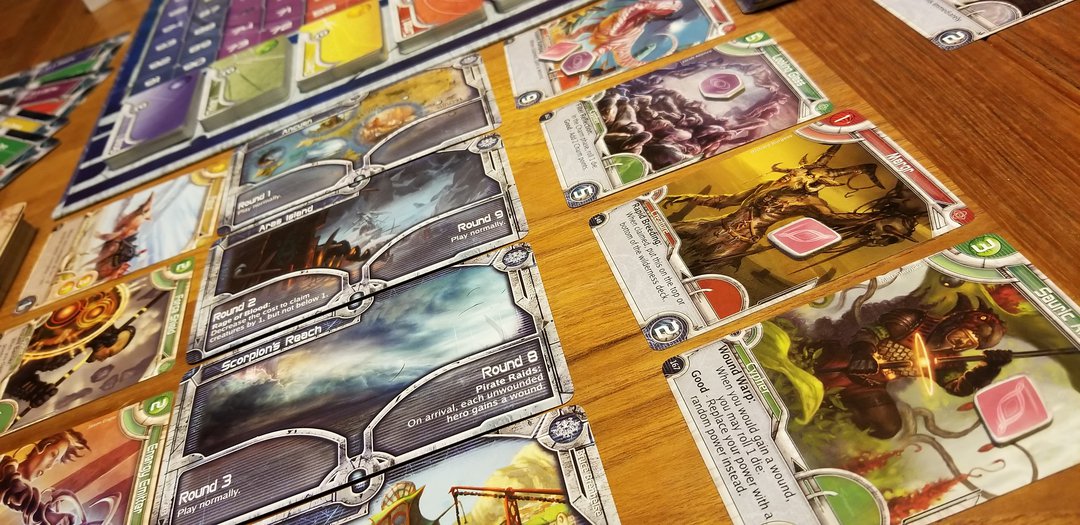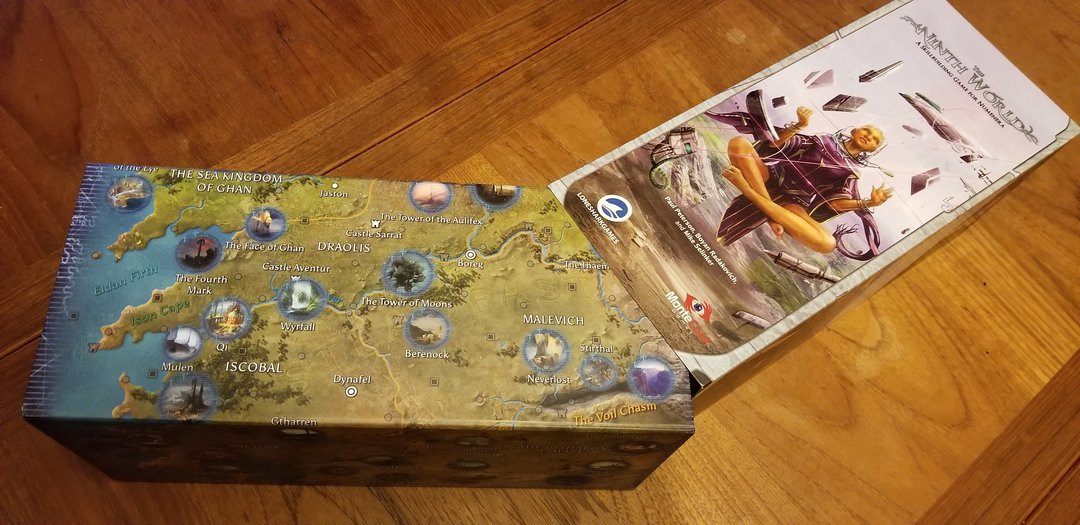The Ninth World: A Skillbuilding Game For Numenera
Publisher: Lone Shark Games
Format: Tableau Building, Card Game
Number of Players: 1 - 5
Play Time: 30 - 60 minutes
Price: $35.99
Copy Provided By Publisher
Imagine living so far in the future that technology and magic seem to be one and the same. A fantastic world full of untamed wilds, magnificent and dangerous creatures, and long forgotten artifacts of untold power. The Numenera RPG system is just such a setting, and now The Ninth World brings that setting in a very manageable package to your tabletop board game nights.
This is a game that I so desperately wanted to fall in love with. Having never played the RPG, I came across the setting at PAX Unplugged and was immediately hooked by its aesthetic. Me, the cyberpunk loving, party-wizard-of-the-Sprite-and-Dice-team coming across this—a world so far in the future that sci-fi has become fantasy. This is my wheelhouse. I had to practically fight Wyatt to release this one into my hands for review.
And yet, like a well-timed shield deflecting danger, I bounced off this game. Might you survive the walk through the wilderness? We’ll see.

The game's score tracker is actually part of the box that unfolds from a magentic latch. A very classy touch!
Play How You Want
The Ninth World calls itself a “skill building game,” and certainly to some degree that’s what this game is all about. You’ll be travelling across the land, stocking up in towns and battling challenges out in the wilderness, all the while honing the five different skills you play during various bidding rounds (one for each skill action). Build yourself up in ability and deeds and make the greatest name for yourself in the competitive mode, or hone yourself with friends in the coop mode to save towns from destruction.
Before I dive into my thoughts on the skill building, though, let me confirm what you may be questioning. You heard right: this game can be played both competitively and as a coop (and by extension, solo). In competitive, you try and outbid the other players with your skill cards to grab quests or kill monsters before your opponents can. In coop mode, you all work to cover threats as they appear in the wilderness while working up everyone’s individual point scores to clear “checkpoints” of a sort as the game progresses. In either case, you do this by spending your skill cards in each phase to claim the cards you want: combat for monsters, charm for quests, and so on, with a card played ‘out of phase’ as a generic +1. My thoughts on a game that works as both competitive and coop are—complicated. Enough so that I’ll save them for later on, but for now I will say that it’s interesting to see a game design that works well in both modes, out of the box, with no need for house rules.
In either mode you choose to play, honing your skills is a critical part of what you do. If you don’t replace your generic “effort” cards with the colored skills you’re missing, and you don’t replace those skills with their higher level versions, you won’t have the strength to deal with more powerful cards as they appear or take part in as many of the action phases as you’d like each turn. The concept of level-ups is one that many games follow, but I found in practice it was a pretty simple upgrade mechanic here: there is no skill tree to worry about, no fancy abilities printed on the skill cards. Just “swap an effort card for Combat 1” and then “swap Combat 1 for Combat 2” a little later on.
That simplicity might be a draw for some, and it certainly makes the game snappy to play, but for me this was the first point from which I bounced off.
Thematic, Yet Not
There’s a lot to like about the look and feel of The Ninth World. The artwork is stunning and highly evocative of the setting, and the box with its magnetic lid and score track it unfolds into all add to the lovely component quality you get in this modestly-sized box (also, I might add, roomy enough for expansions, which I always appreciate). Each character comes with a short bio on the back of their oversized card, further adding to the flavor of the game. Sadly for me, a player with no prior knowledge or experience in the Numenera RPG system, the theme ends there. Aside from the brief setting overview we’ve come to expect from the start of rulebooks, there is no further explanation of anything in the game. There is no flavor text on the multitude of cards. There is no additional storytelling element to tell me more about the towns I’m saving. Everything in the game is printed simply: prominent (and again, lovely) card art, costs, and abilities.
Because of that lack of additional storytelling, I found myself often looking past the artwork and simply reading the abilities on all the cards, making choices based solely on cost versus rewards. Quest cards, for example, were phrased as simply “do X for Y amount of times, earn Z points” and didn’t make me feel as if I’d actually traveled anywhere or accomplished anything more than ticking a checklist. For a world so steeped in lore as to hold up an entire RPG setting, I was disappointed that the card game didn’t tell more of a story about my character as I played it.

Chips In The Armor
Overall, I find The Ninth World just a little too simple for my liking. That doesn’t make it a bad game; in fact I think the mechanics and core gameplay of upgrading your skill cards, spending those skills to defeat challenges, and collecting a tableau of acquired cards to further add to your power, are a tried and tested formula. Mechanically, the systems work, and the game itself is still reasonably fun to play. It also comes with a whole set of location cards and extra abilities that you can deal out in setup, adding to the variety of a game that will never have exactly the same adventure each time you play. Though it will play largely similarly.
The game on offer isn’t a bad game, but I take issue with calling it a “skill building game.” I went in expecting a game where you really hone a special character, building a unique skill set and taking it out into the wilderness. An RPG system given boardgame form! What I found instead was a streamlined system of “exchange number 1 for number 2.” Level ups in their most basic sense. You level up skills in all kinds of games, but I wouldn’t call a game like Mageknight or Runebound “a level up game.” Those games have lots of concurrent systems, abilities to cycle through, other actions you perform, and they always make you feel special in the context of how your character defeats challenges. In other words, it’s never strictly about the level up; it’s what you do with your new powers. With The Ninth World, no matter how experienced you get or what cards you acquire to augment your abilities, the basic game loop is only ever “spend some skill cards, scout/tinker/charm/battle a card, and claim it.”

Cards for locations, cards for the wilderness challenges. Everything can be rotated every time you play and set up in minutes.
And this is where I’ll come back to my thoughts on the game being both competitive and cooperative. You see, while both modes work, the coop mode seems clearly superior. Even talking to folks at PAX Unplugged, it became apparent that coop mode was by far the preferred way to play The Ninth World. While trying to outbid opponents in competitive mode is a nice idea, in practice it’s a bit boring. You bid, and either you win and get a thing before someone else gets the thing, or you fail to get the thing and end up funneling the used skills into something less optimal. Coop allows players to dig in and fight the game together, struggling as it spits more and more cards at them as they desperately try to work as a team to keep up with it. Coop is where the adventure really seems to be at. What does the game gain by including a competitive mode, I ask?
It’s a shame because when it comes down to it, despite the different ways to play, there really isn’t much to hold my interest in this game. That “spend some skills, get some cards” mechanic is basic and it’s snappy, but it also lacks for depth. I almost wish the developers had just scrapped the competitive mode altogether and channeled that energy into making the coop experience even more robust. I was able to sit down and knock out some solo games over the holidays, and I have to say there’s appeal in having a game that I can set up in five minutes and play in thirty. But after playing it a few times, I’m no longer eager to set it up just to run through its motions again and again. I’ll say it again: this is not a badly designed game! It works well. But I wouldn’t mind a longer setup or even a longer play time if the experience it offered made me feel more like I was actually adventuring in a world of rich lore instead of using cards to collect other cards. Wonderful artwork aside, this game just didn’t pack any “wow” factor for me.

The box itself has the map of Numenera printed on its backside. The production quality of the components themselves is really quite good.
Wrapping Up The Journey
For me, personally, this game is a pass, but I could see it on some gamers’ shelves all the same. In a lot of ways, it reminds of another game, the now out-of-print Discworld game. That was another game that, while mechanically very solid, offloaded most of its thematic responsibilities to the players. I played it with a group of friends who had read the books (I had not), and while I enjoyed the game for what it was, I didn’t get any of the references or care about who any of the characters were. My friends, by comparison, made all kinds of jokes and comments, laughing as they played, based on nothing more than a card’s name and its artwork.
These are the kinds of players that I think would appreciate The Ninth World most. People who are already fans of the Numenera RPG and will fill in the gaps with all they already know about the setting. I could also see this game appealing to a group that wants a light, solid, quick coop game to play together, as this game is still really good for that. So if after all my concerns, the streamlined gameplay sounds like something your group would still enjoy, I encourage you to check it out. If not, there’s no harm in letting this one pass you by. You’ll know which adventuring group you’re sticking with.